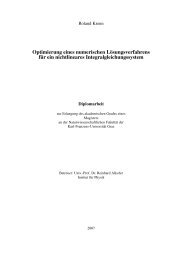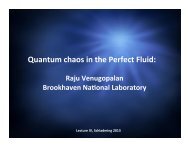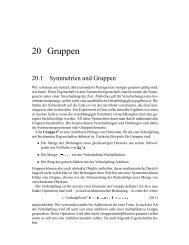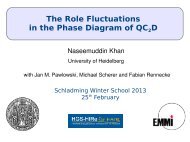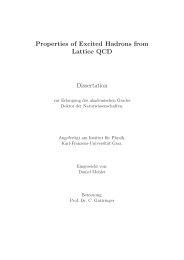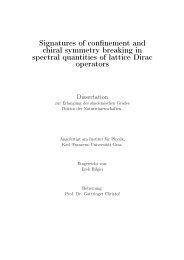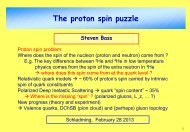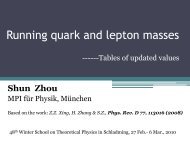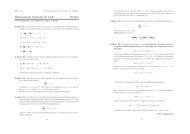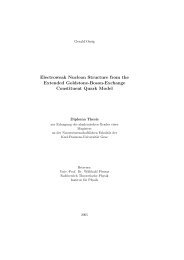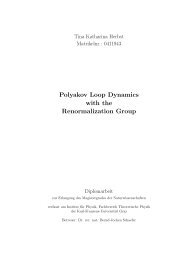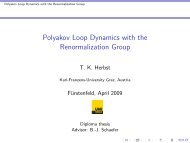The QCD Quark Propagator in Coulomb Gauge and - Institut für Physik
The QCD Quark Propagator in Coulomb Gauge and - Institut für Physik
The QCD Quark Propagator in Coulomb Gauge and - Institut für Physik
Create successful ePaper yourself
Turn your PDF publications into a flip-book with our unique Google optimized e-Paper software.
Chapter 1. Prologue 3<br />
an ultraviolet cutoff differs <strong>in</strong> some respects from a complex non-abelian gauge theory like<br />
<strong>QCD</strong>. In a number of more realistic models which are based on approximations of the<br />
gluon sector of <strong>QCD</strong> it has however been shown, that chiral symmetry is broken <strong>in</strong> the<br />
manner as discussed by Nambu <strong>and</strong> Jona-Las<strong>in</strong>io, if the attraction exceeds a critical level<br />
[ALYO + 83, FGMS83]. Particularly an <strong>in</strong>stantaneous conf<strong>in</strong><strong>in</strong>g <strong>in</strong>teraction always causes<br />
spontaneous break<strong>in</strong>g of chiral symmetry [DM85].<br />
In <strong>Coulomb</strong> gauge such an <strong>in</strong>teraction has been identified for heavy quarks, which is an<br />
advantage compared to covariant gauges. <strong>The</strong> approach to study <strong>QCD</strong> <strong>in</strong> different gauge<br />
fixed formulations is an <strong>in</strong>terest<strong>in</strong>g <strong>and</strong> well established endeavour. In general, Green’s<br />
functions are gauge dependent objects. Of course conf<strong>in</strong>ement <strong>and</strong> dynamical mass generation<br />
are experimentally observable phenomena <strong>and</strong> as such must have gauge <strong>in</strong>dependent<br />
theoretical signatures. Conf<strong>in</strong>ement is reflected <strong>in</strong> the long distance behaviour of the<br />
(gauge <strong>in</strong>variant) Wilson loop <strong>and</strong> the strength of dynamical chiral symmetry break<strong>in</strong>g is<br />
determ<strong>in</strong>ed by its (gauge <strong>in</strong>variant) order parameter, the chiral condensate. On the other<br />
h<strong>and</strong> it may very well be that the detailed mechanism that generates these quantities depends<br />
on the choice of gauge. Moreover possible order parameters separat<strong>in</strong>g the conf<strong>in</strong><strong>in</strong>g<br />
from the deconf<strong>in</strong><strong>in</strong>g phase of gauge theories may only be identifiable after gauge fix<strong>in</strong>g.<br />
<strong>The</strong> next chapter reviews aspects of chiral symmetry break<strong>in</strong>g <strong>in</strong> <strong>QCD</strong>, which are vital<br />
for the follow<strong>in</strong>g chapters. Start<strong>in</strong>g with formal descriptions <strong>and</strong> implications we consider<br />
the def<strong>in</strong>ition of a mass function <strong>and</strong> its properties, PCAC <strong>and</strong> the special role of the pion.<br />
<strong>The</strong> third chapter gives an overview concern<strong>in</strong>g efforts <strong>in</strong> <strong>Coulomb</strong> gauge connected<br />
to this thesis. After a short motivation <strong>and</strong> comparison to L<strong>and</strong>au gauge DSE studies we<br />
report the status of the renormalisability proof. A brief discussion of different approaches<br />
<strong>in</strong> <strong>Coulomb</strong> gauge follows. <strong>The</strong> quantisation of Maxwell theory <strong>in</strong> comparison with Yang-<br />
Mills theory is demonstrated <strong>and</strong> the differences <strong>in</strong> the results are highlighted. In the<br />
rema<strong>in</strong>der we review the Gribov-Zwanziger conf<strong>in</strong>ement scenario.<br />
In chapter four we start out with deriv<strong>in</strong>g the quark Dyson-Schw<strong>in</strong>ger equation from the<br />
<strong>QCD</strong> action <strong>and</strong> via Ward identities. We solve it <strong>in</strong> <strong>Coulomb</strong> gauge at first keep<strong>in</strong>g only the<br />
time-time component of the gluon propagator <strong>in</strong> the <strong>in</strong>stantaneous approximation. This<br />
improves on the approximation <strong>in</strong> ref. [Alk88] us<strong>in</strong>g the so-called Richardson potential <strong>in</strong><br />
the gluon propagator <strong>and</strong> a MOM scheme for renormalisation. Improv<strong>in</strong>g the truncation<br />
we solve the gap equation <strong>in</strong>clud<strong>in</strong>g transverse gluons <strong>and</strong> retardation. <strong>The</strong> presented<br />
results are compared.<br />
Chapter five utilises these solutions <strong>in</strong> order to ga<strong>in</strong> qualitative <strong>in</strong>formation about<br />
meson <strong>and</strong> diquark properties. Explicitly we demonstrate that diquarks are conf<strong>in</strong>ed <strong>and</strong><br />
it is nevertheless possible to assign them a f<strong>in</strong>ite charge radius.



